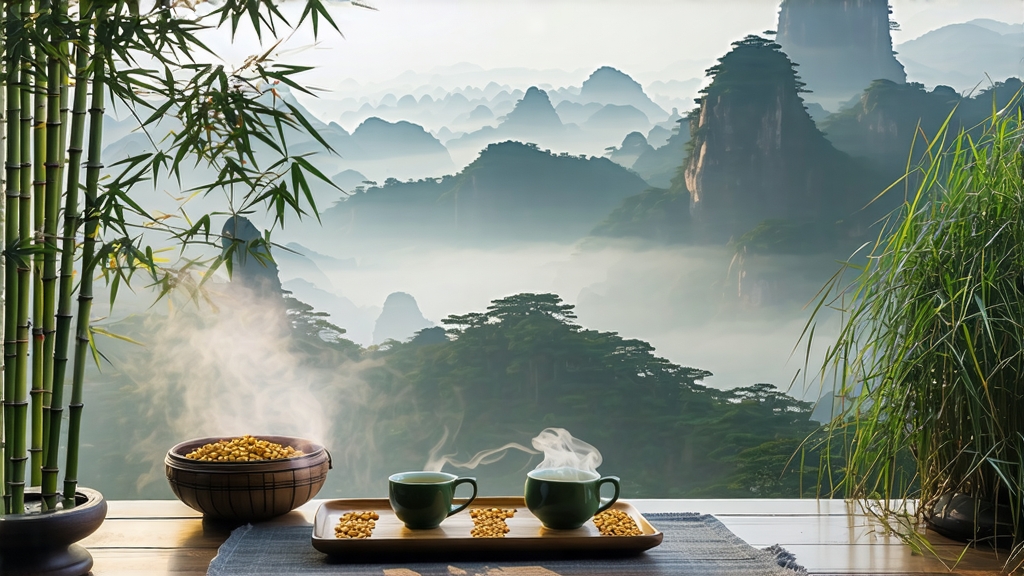
Tucked high in the mist-veiled Dabie Mountains of western Anhui Province, Huoshan Huangya has quietly captivated Chinese emperors, poets, and tea sages for more than seven centuries. To the global tea traveler it remains one of the least-known jewels of the six major Chinese tea classes, yet its gentle yellow liquor carries a lineage as regal as any dragon-well or phoenix oolong. This essay invites you to journey from Tang-dynasty tribute lists to twenty-first-century micro-lots, unpacking the history, cultivars, craft, and cupping rituals that define Huoshan Huangya—literally “Huoshan Yellow Bud.”
-
A bud in the mountain mist: historical outline
The first written record appears in the Huoshan County Annals of 813 CE, which notes that “yellow buds from Miaojiang valley” were levied as spring tribute. During the Ming dynasty the tea was so coveted that caravan drivers greased their cart axles with tea leaves to mask the scent from bandits. When the Kangxi Emperor tasted it in 1702 he declared it gong cha (“palace tea”), a status reaffirmed by his grandson Qianlong, who carried sealed canisters on southern inspection tours. European diplomats encountered it in 1915 at the Panama-Pacific International Exposition, where it won a gold medal, yet wars and the decline of Qing court demand pushed it to the brink of extinction. A state-led revival in 1972 re-grafted ancient trees, re-documented withering protocols, and re-established micro-climatic gardens between 300 m and 800 m elevation, ensuring the survival of what is today China’s northernmost yellow tea. -
Terroir and cultivars
Huoshan County lies on the northern edge of China’s subtropical belt. Granite soils, 90 % relative humidity, and a 15 °C annual mean create a slow, tension-building growth cycle. The indigenous group is called Huoshan early-sprouting small-leaf; its buds are triangular, downy, and olive-green rather than the purplish hue of many southern cultivars. Two clones dominate modern gardens: Jinfeng (“golden phoenix”), prized for orchid fragrance, and Dabie #1, selected for frost resistance and thicker polyphenol suite. Gardens are intercropped with sweet-scented osmanthus and bamboo, whose fallen leaves act as a natural mulch, moderating soil temperature and adding a faint bamboo-sap note to the finished tea. -
From pluck to smother: the yellowing art
The defining step that nudges green tea toward yellow is menhuang—“sealed yellowing.” On the first sunny day after Qingming (early April) pickers climb terraces at dawn to gather the standard “one bud with one unfolded leaf,” about 2.5 cm in length. The leaf must be transported in bamboo sieves within two hours to prevent enzymatic bruising.
Withering is brief: 2–3 hours on perforated bamboo trays set 1 m above gentle charcoal embers. The goal is 65 % moisture loss and a grassy note that drifts toward cucumber. Next comes high-temperature shaqing (kill-green) at 160 °C on a cast-iron wok for 40 seconds—just enough to denature polyphenol oxidase while preserving carotenoids that will later tint the liquor gold. Immediately the leaves are rolled for six minutes under 6 kg pressure to break 30 % of cell walls, releasing amino acids that feed the coming microbial bloom.
Now the tea embarks on its unique detour. Piles of 4 kg are wrapped in steamed cotton cloth, then placed inside a bamboo chamber lined with fresh chestnut leaves. The chamber is slid into a 32 °C, 75 % humidity cave for 36 hours. During this menhuang phase thermophilic bacteria (Bacillus subtilis predominating) convert catechins into theaflavins and generate 2-acetyl-1-pyrroline, the same aroma compound that gives basmati rice its popcorn nuance. Every eight hours the pile is uncovered, fluffed, and re-wrapped; masters judge readiness by sniffing for a shift from “green bean” to “fresh corn milk.” Finally the leaf is slow-dried at 55 °C in three stages over eight hours, locking in 5 % residual moisture and a downy golden sheen.